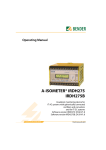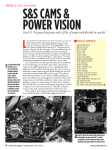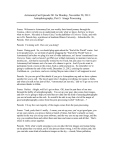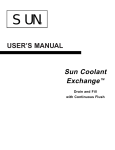Download 2.5 Liter Twin Cam 2.5 Liter Twin Cam 2.5 Liter
Transcript
2.5 Liter Twin Cam Engine Valve Adjustment T he first versions of the 2.5 liter twin cam engines employed non-hydraulic valve actuation. Like the timing belt, the clearance between the engine valves and the shim and bucket valve actuators does not require inspection and/or adjustment until 105,000 miles have elapsed. However, various circumstances may require an adjustment before that milestone is reached. Clearance is tight (sorry about the pun) and there is little room to work between the cylinder heads and the left and right frame rails. A special tool (ST 49818700) is available for depressing the valves and removing the adjusting shims. Without this tool, the job is impossible to accomplish with the engine in the car. Once again, we had the benefit of working on an engine that had already been removed from the car. Before you can adjust the valves, the engine must be cold. Consult the service manual to determine the parts that will need to be moved or removed to make some room to work. Both right side resin camshaft sprockets have a single arrow embossed on their front surfaces. The position of these arrows determines which valves are to be measured and/or adjusted. To begin the procedure, turn the crankshaft pulley clockwise until the camshaft sprocket arrows are pointing to the position shown in the The End Wrench Unlike some overhead cam engines that require you to rotate the cam until each cam lobe is facing 180 degrees away from the adjustment shim, Subaru has very specific procedures for adjusting four valves at a time (a pair of intakes and a pair of exhausts). The pairs of intakes and exhausts are never for the same cylinder, which makes things rather interesting. This system requires you to turn the crankshaft a total of four times to complete the adjustment procedure. 20 figure below (approximately 2 o’clock position). In this position, the #1 intake valve and #3 exhaust valve clearances can be inspected and the clearance adjusted as necessary. position shown in the figure below (approximately 4 o’clock position). In this position, the #2 exhaust valves and the #3 intake valves can be measured and/or adjusted if necessary. Just remember, if a valve requires adjustment, make sure the camshaft sprockets are in the proper position before attempting to depress the valve or remove a shim. This will prevent any unintentional valve interference problems. Valve Adjustment Tool and Adjustment Procedures Insert a thickness gauge between the heel of the camshaft and the adjusting shim. Keep the thickness gauge as close to parallel with the shim surface as possible. The exhaust valve clearances are more easily measured while working from beneath the vehicle. The valve clearance specifications for these engines are: Next, rotate the crankshaft pulley clockwise until the right side camshaft sprockets are in the position shown in the figure below (approximately 8 o’clock position). In this position, the #2 intake valves and the #4 exhaust valves can be measured and/or adjusted if necessary. • Attach the second half (part B) to part A by sliding its pins through the slotted holes in part A. • Exhaust valves 0.25 mm ± 0.02 mm. The End Wrench • Install the eccentric bolt (part C) into the hole in part A. Finally, rotate the crankshaft pulley clockwise until the right side camshaft sprockets are in the position shown in the figure below (approximately 10 o’clock position). In this position, the #1 exhaust valves and the #4 intake valves can be measured and/or adjusted if necessary. The eccentric bolt forces parts A and B away from one another. Because part A can’t move (it’s wedged against the cam lobes), the only thing that can move is part B. Part B moves by forcing the shim buckets downward, away from the camshaft. If the clearance for any of the first set of valves is more than 0.02 mm beyond the specification, write down the actual clearance. You’ll need the information later to determine which shim to install to bring the clearance into specification. Continue the measurement procedure by rotating the crankshaft pulley clockwise until the right side camshaft sprockets are in the The tool installed in the three steps: • Wrap the first half of the tool (part A) around the lobes. • Intake valves 0.20 mm ± 0.02 mm. An assortment of 60 shims is available, in 0.01 mm increments, so it’s theoretically possible to get each valve adjusted to exactly its clearance specification. But if the valve adjustment is within 0.02 mm of the specification, do not remove the shim. Changing a single shim size will only bring it 0.01 mm closer to perfection. Moving up (or down) two sizes may cause you to overshoot the specification on the other side. As we mentioned, it takes a special tool to work within the limited clearance area between the cylinder heads and the frame rails. The ST 498187 is a threepart tool. One part wraps around the cam lobes, a second touches the outer edges of two shim buckets, and a third eccentric bolt exerts the necessary pressure to push a pair of shim buckets away from the cam lobe to make shim removal and replacement possible. You may prefer to adjust the valves as you go, or measure them all before returning to adjust those valves that require adjustment. 22 Each shim bucket has a notch cut into its edge to facilitate shim removal. With the shim replacer tool locked into position, use a dental pick to force the adjusting shim out of its slot in the shim bucket. Use a needle-nosed pliers or magnet to lift the shim clear of the shim bucket and camshaft. S equals the new shim thickness to be used. 0.25 mm, the recommended clearance. V equals the measured valve clearance before adjustment. When reinstalling the adjustment shim, always position the shim so its number side faces away from the cam lobe. This will keep the cam lobe from wearing the numbering away, which will make it easier to identify the shim the next time it needs to be removed. T equals the original shim thickness. Use a micrometer to measure the thickness of the removed shim. Here’s where your earlier clearance measurements come into play. To determine the required replacement shim thickness use the following formulas for intake and exhaust valve shims. For intake valves: S = (V + T) - 0.20 mm For exhaust valves: S = (V + T) - 0.25 mm Let’s plug in some numbers to see how it works. Let’s say our measured valve clearance for an exhaust valve was 0.30 mm. That’s more than 0.02 out of specification, so an adjustment is required. When we remove the existing shim, we find that it is 2.38 mm thick. S = (0.30 + 2.38) - 0.25 S = 2.68 - 0.25 S = 2.43 mm So the replacement shim (2.43 mm) is exactly 0.05 mm thicker than the original shim. This will reduce the valve clearance by 0.05 mm, which will put it exactly at As the old saying goes, reassembly is the reverse of disassembly. There are no special tricks along the way. Do it like the carpenters do — measure the shim twice, replace it once.










